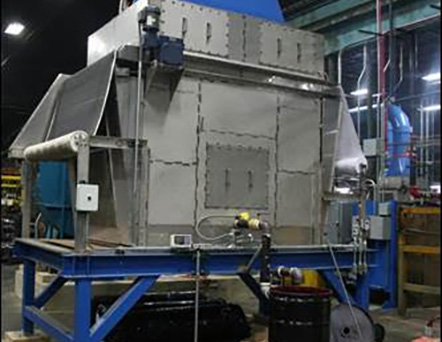
Background
A Fortune 1000 roofing material company has a plant that produces a variety of roofing products for commercial and residential use. During the production process, an asphalt-based laminate is applied to a substrate prior to the addition of sand on the roofing products.
The asphalt-based laminate is applied at high temperature, and a portion of the hot fumes coming off this laminate quickly condense into fine droplets as they come in contact with the cooler, ambient plant air. These fine, submicron oil mist droplets suspend in the plant air, forming a heavy haze/fog inside the plant. Additionally, the finest dust from the sand application process also escapes into the plant air.
It was not beneficial for plant employees to be exposed to this haze/fog on a daily basis. Indeed, on the worst days it could be difficult for maintenance personnel to breathe normally when working on equipment in the upper levels of the plant.
Objective
The plant engineering group’s objective was to eliminate the oil mist haze/fog inside the plant and improve plant air quality. The plant chose to vent the air to atmosphere after cleaning, and as such, the cleaned air discharged to atmosphere was required to have no opacity (i.e., no visible emissions) and virtually no remaining particulate. Last, the plant required a system that is proven, reliable, and low maintenance, allowing continuous 24/7 operation with no downtime.
Action and Result
The company had used APC’s Ultra-High Efficiency Filter (UHF®) system with excellent results for cleaning the indoor plant air at another operating location, removing fine, suspended glass and paper dust in that instance, with the cleaned air recycled back into the plant, and thus evaluated the UHF® system for the present application. APC was selected to furnish and install a 30,000-ACFM UHF® system, including two new hoods, ductwork, UHF® filter unit, system fan, a new stack, and instruments and controls. The UHF® system was judged to be relatively low in capital and operating cost, while being able to deal with the challenging, sticky liquid/solid particulate combination of submicron oil mist droplets and very fine sand dust particulate.
Within approximately ten minutes of system start-up, the indoor haze in the plant had completely disappeared, meeting the primary objective of the project. Equally important, the clean air exhausted from the system to atmosphere through the stack showed zero opacity. The UHF® unit has had no downtime, and the plant is very pleased with the installation, economically and on a performance basis. The UHF® system provided these benefits at lower capital and operating cost than any other option.